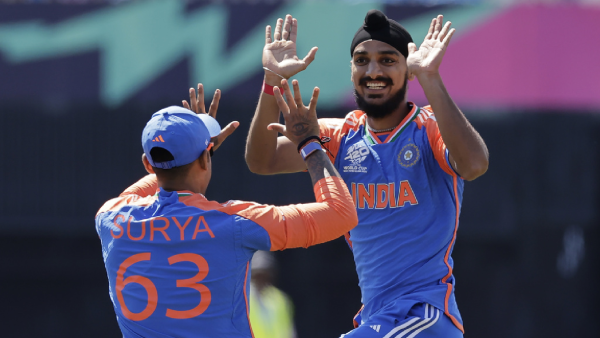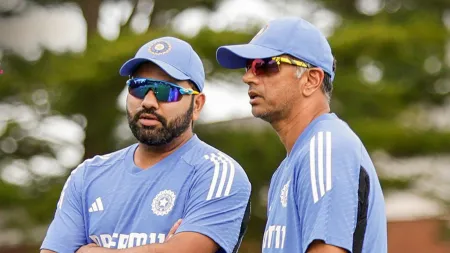T20 World Cup: Joy of watching Bumrah & Co bowl from Marshall, Garner, Ambrose, Roberts End
In the halcyon days of Caribbean quicks, the scoreboard operators of the grand old Sabina Park in Kingston would play a spooky prank on the visiting batsmen. “When they came for warmups in the morning of a match, they would put just our names on the scoreboard. Holding, Roberts, Marshall, Garner, two-three times. No batsman, no wicket-keeper. It terrified the batsmen even before the first ball was bowled,” the legendary Andy Roberts once told this newspaper.
Their glorious era has long departed, living now through tales and memories. As tombstones of a lost inheritance, the bowling ends, and stands, flash their names in most stadiums in the Caribbean. Some of their most fearsome fast bowlers have departed, some stay detached from the sport, some embraced anonymity, but this World Cup, fast bowling, in its broadest sense, has become the primal force again.

Their numbers reflect their primacy—fast bowlers, of all hues, have prised out 68.9 percent of the total wickets in the tournament. On Monday night, New Zealand’s 150-kph speedster Lockie Ferguson achieved the rare feat of bowling four maidens in a row.
At this T20 World Cup, the ten most economical bowlers are pacers and they have also captured seven spots on the Top 10 wicket-takers list. Once in every four games, a fast bowler has been adjudged the player of the match. But beyond the numbers or their role in setting up games, they have achieved a bigger feat. They have been genuine spectacles, the audience breathlessly awaiting them, the batsmen truthfully fearing them.
Boom boom show
Fast bowling is the most athletic pursuit in the game; the most basic and purest thrill in watching cricket is a really quick fast bowler at his physical peak, subjecting the batsmen to misery, splaying stumps, blasting pads, and spreading a whiff of danger.
As though replicating to the millennials on how the West Indies phalanx went about their business in the 70s and 80s, India’s Jasprit Bumrah is turning back the clock. Every spell of his has immense archival value. Most wickets he takes are a spectacle – the straightener to snare Babar Azam, the nip-backer that thundered the stumps of Mohammed Rizwan, the meltdown moment of a famous heist. Both resembled men trying to fend off a firing squad with the bat.
 India’s Jasprit Bumrah, left, celebrates with teammates the dismissal of Pakistan’s Mohammad Rizwan, right on ground, during the ICC Men’s T20 World Cup cricket match between India and Pakistan at the Nassau County International Cricket Stadium in Westbury, New York, Sunday, June 9, 2024. (AP Photo/Adam Hunger)
India’s Jasprit Bumrah, left, celebrates with teammates the dismissal of Pakistan’s Mohammad Rizwan, right on ground, during the ICC Men’s T20 World Cup cricket match between India and Pakistan at the Nassau County International Cricket Stadium in Westbury, New York, Sunday, June 9, 2024. (AP Photo/Adam Hunger)
Just a pair of fours and six have been hit off the 72 balls he has bowled; of them 42 have been dot balls too. A strike every 13th ball, an economy rate of 4.09, he has been the grandest spectacle of the season. He is the driving force behind India’s quest to end their ICC trophy drought, ably supported by Arshdeep Singh, swinging the new ball to his whims.
Rabada-Nortje threat
Before they bound in from either the Malcolm Marshall End or the Joel Garner End against Afghanistan in Barbados, South Africa’s pace pair Kagiso Rabada and Anrich Nortje would snarl from either the Curly Ambrose End or the Andy Roberts End at Antigua.
Rabada, all supple athleticism, has not yet hit the high notes, but has quietly gone about his business. But batsmen would need no reminders of his capacity to blow them apart. His accomplice Nortje is a firebrand, feeding off his inner rage like his idol Dale Steyn, emerging as South Africa’s callous enforcer. He has rediscovered his pace, regularly hitting the early 150 kph mark, and the ability to swing the ball late into the right-handed batsmen. He benefited from the variable bounce on offer in New York, (where he dismantled Sri Lanka) as well as the moisture on the surface in the early starts.The decks in the West Indies would get progressively slower as the tournament drags on, but Nortje wouldn’t compromise on his biggest strength.
 South Africa’s Anrich Nortje, right, celebrates with teammate Keshav Maharaj after the dismissal of Sri Lanka’s Charith Asalanka during the ICC Men’s T20 World Cup cricket match between South Africa and Sri Lanka at the Nassau County International Cricket Stadium in Westbury, New York, Monday, June 3, 2024. (AP/PTI)
South Africa’s Anrich Nortje, right, celebrates with teammate Keshav Maharaj after the dismissal of Sri Lanka’s Charith Asalanka during the ICC Men’s T20 World Cup cricket match between South Africa and Sri Lanka at the Nassau County International Cricket Stadium in Westbury, New York, Monday, June 3, 2024. (AP/PTI)
Neither would Jofra Archer and Mark Wood. A David Warner assault in the opening game aside, Wood has been quick, consistently clocking upwards of 150kph, and accurate. His long-injured partner Archer, of Barbadian bloodline himself, has masterfully mixed his speeds, fooling batsmen with devious change of pace. One ball to Travis Head was 146 kph, another 30-odd kph slower, castling the Australia opener. Such variations could be more commonly-spotted in the Super Eight, where cutters and slower balls would be stock weapons, even though the wise would slip in the immortal line “pace is pace yaar.”
Less speed, same dread
But it’s not just those with pace that have thrived. There had been all sorts—speed demons, seam and swing kings, left-arm seamers, dibbly-dobbly variety, cutter-merchants. Both Arshdeep and Fazalhaq Farooqi (the highest wicket-taker), left-armers, are lively rather than rapid. Yet, with their angles, the ability to seam with the new ball, discipline and smarts, have prospered.
 India’s Arshdeep Singh, right, celebrates with teammate Suryakumar Yadav after the dismissal of United States’ Shayan Jahangir during the ICC Men’s T20 World Cup cricket match between United States and India at the Nassau County International Cricket Stadium in Westbury, New York, Wednesday, June 12, 2024. (AP Photo/Adam Hunger)
India’s Arshdeep Singh, right, celebrates with teammate Suryakumar Yadav after the dismissal of United States’ Shayan Jahangir during the ICC Men’s T20 World Cup cricket match between United States and India at the Nassau County International Cricket Stadium in Westbury, New York, Wednesday, June 12, 2024. (AP Photo/Adam Hunger)
Farooqi had rendered balance to the historically spin-heavy Afghanistan bowing firm. Like Afghanistan, the traditionally left-arm spinners-oriented Bangladesh have relied on their medium pacers, Mustafizur Rahman, Taskin Ahmed and Tanzim Hasan Sakib. The trio have snared 23 off the 33 wickets they have plucked, reducing the spinners to bit-part roles. In the going with the trend, even the scattergun Alzarri Joseph, has managed to marry speed with accuracy.
An aberration has been Australia’s pace trio of Mitchell Starc, Josh Hazlewood and Pat Cummins who have combined to snaffle one wicket fewer than leg-spinner Adam Zampa (9). But the three are proven performers in crunch games and clutch junctures and shouldn’t be taken lightly.
Top Sports News Now- T20 World Cup: Joy of watching Bumrah & Co bowl from Marshall, Garner, Ambrose, Roberts End
- Neeraj Chopra at Paavo Nurmi Games 2024 Live Updates
- T20 World Cup: How India's Super 8 group looks like – opponents H2H, venues and weather forecast
The exit of Pakistan, New Zealand and Sri Lanka would leave the fare poorer, but this has been a festival of fast bowlers. And it could get more thrilling, as Bumrah and his fraternal friends turn on the afterburners. It couldn’t be more fitting—pacers shining in the land of the most fearsome pacers. And just their names on the scoreboard could spook batsmen.
Get latest updates on T20 World Cup along with live score updates for all matches.
Disclaimer: The copyright of this article belongs to the original author. Reposting this article is solely for the purpose of information dissemination and does not constitute any investment advice. If there is any infringement, please contact us immediately. We will make corrections or deletions as necessary. Thank you.





